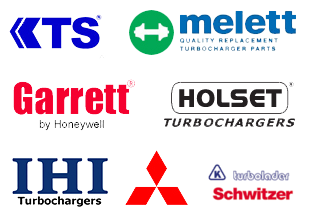Turbine repair
The turbine has a history of more than half a century.
Throughout this time, car technology has required engine development. There is a fierce battle to increase power and economy. All this requires new materials and technologies.
Modern turbochargers for passenger cars are high-tech units, so turbocharger repair is a complex process that requires maximum attention, technical skills, quality repair materials and modern equipment.
Turbomotors offers qualified turbocharger repairs for petrol and diesel engines.
Typically, turbocharger repairs take 1-2 working days. For the convenience of our customers, we have created a trade-in pool of refurbished popular TKRs. If required, we can offer a refurbished turbocharger option from our in-stock trade-in pool.
DESCRIPTION OF THE REPAIR PROCESS
1. Primary inspection, dismantling and multi-level cleaning
The turbocompressor that our customers bring in for repair is subjected to a mandatory type-approval, overall condition and serviceability check, and is thoroughly disassembled. Parts with external damage, unacceptable wear, broken or cracked, incompatible with the future operation of the turbocharger, with high levels of corrosion, chemical attack or contamination shall be discarded and not used in the subsequent remanufacturing process.
Each component that passes the test enters a multi-stage cleaning line where, in the first stage, the parts are cleaned by sovlent in manual and hot automatic washers and by ultrasonic cleaning. The parts are then sandblasted with special abrasive materials, after which they again undergo a cleaning cycle in a clean hot automatic washer to remove any residual abrasive, followed by drying with inspection of the cleaned surfaces and then corrosion treatment.
2. Inspection, measurement and evaluation
After cleaning, the turbine parts are again inspected and measured and after these procedures can be used in the further refurbishment process. The inspection is carried out by technical staff and includes:
1. Visual inspection of the surfaces;
2. detection of hidden cracks prior to cleaning;
3. measurement of parts with micrometer and digital gauges;
4. calibration tests and comparison with a template;
5. Actuator testing.
3. Selection of components to be replaced
All turbochargers undergoing a refurbishment cycle shall receive a minimum standard set of new parts:
Journal bearings
Thrust bearing
Turbine ring
Compressor ring
Compressor wheel nut
Seals
Parts such as the turbine rotor, compressor wheel, bearing housing, variable geometry drive, actuator can be replaced as required or if they were rejected at previous levels.
In certain cases, the installation of repair sizes of rings and plain bearings is allowed.
4. Balancing turbocharger components
The turbine rotor (turbine whell) and the compressor ring (compressor wheel) are subjected to dynamic balancing on a power-driven horizontal balancing bench. After the rotor and the impeller have been individually balanced, they are reassembled and rebalanced on the balancing bench to 5000 rpm.
5. Turbocharger cartridge (CHRA) reassembly
All prepared parts, as well as the balanced rotors and impellers, are assembled by the technician into the bearing housing of the turbocharger cartridge.
6. Balancing the CHRA
After assembly, the cartridge shall undergo high-speed balancing (up to 250,000 rpm) and oil leak testing. For small turbochargers, mainly used in passenger cars and light commercial vehicles, we use the computerised balancing bench Turbotechnics MK3 from the English manufacturer.
For truck and special machinery turbochargers, a separate computerised stand TMI Modificata is used, with a programme specifically designed for truck turbochargers.
When the balancing is complete, the operator prints out the control data from the test bench, confirming that the turbocharger has passed the given test, indicating the location, date, time, type of turbocharger and its original number.
7. Assembly and checking
After the final balancing, the cartridge enters the final assembly stage and is installed in the “slugs” (turbine housing and compressor housing). After the actuator is installed, the turbocharger is assembled for the final check and calibration of the actuator.
Equipment to be used:
REDAT GateTest3 – electronically-mechanical actuator for testing and calibration of actuators, including turbochargers with VNT system. Testing of electronic actuators with VNT system servo drives.
ATD-1 – Electronic tester for testing electronic actuators with VNT servo drives.
8. Packaging and transport
After the last test, the product is packed in a polyethylene bag, fitted with some types of sealing, then packed in a cardboard box together with the individual card of the turbocharger containing the original printout of the control data from the test bench, the data on damage and its possible causes before repair, warranty obligations and general recommendations for the installation and operation of the turbocharger.
After packing, the turbocharger is delivered to the warehouse or sent directly to the customer by courier (TNT, DPD, Cargobus, Autopasts) within and outside Latvia, or by our company’s courier within Riga city limits.
Usually turbocharger repairs take 1-2 working days, if necessary we can offer a remanufactured turbocharger option from our stock exchange pool.
9. Warranty
The turbocharger repairs, parts installed or new turbocharger warranty period is 1 year, unlimited mileage, subject to vehicle service intervals.

Latvia
LLC Turbomotors
Workshop – Dzirkalu street 44, Riga
info@turbomotors.lv
Estonia
Turbomotors OÜ
Aiandi tee 19/3, 74001,
Viimsi alevik, Harjumaa, Eesti
info@turbomotors.ee
